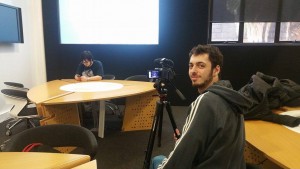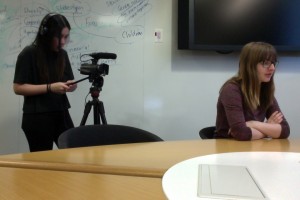Originally I joined a team who wanted to make a web-series about a witch that sells potions like a pharmaceutical sales rep. Unfortunately this web-series would never see the light of day, because one of the media people dropped out and all those remaining were all split up to the other groups of our choosing. I chose “Tit’s up”, thinking it would be a lot of fun because of the concept behind it. The concept being that its an office where two characters, including Grace (the main) are both up for promotion, despite Grace being a smarter and harder worker. The office works with “clients” who are actually the recently deceased. The office is essentially purgatory.
Throughout the semester, there were many stages, both invigorating and aggravating, in our group’s attempt to create “Tit’s up”. One of the problems was the strange requirement by our writing team to not reveal our point of difference until the very end, in which the office actually is the waypoint between our life and that of the afterlife. Thus, instead of having an interesting web-series about the waypoint purgatory acting like an office, we have (for the most part), just a dull, boring office-sitcom. I still don’t understand why they wanted to keep this twist a secret for the entire season. On top of this, the place picked for shooting was a study area, which was going to get more and more crowded the closer we got to the due date and exam week. We also had trouble being able to shoot at night (for the pilot episode) and we eventually had to compromise and shoot it in the day.
As mentioned, shooting delays for the pilot were common, and we shot episodes 2 and 3 before the pilot. We also decided that due to consistent filming delays as a result of conflicting schedules by actors and media people (as well as final assignments for other classes and thus students using the study area more often), we would film and release the first 3 episodes of our series and then afterward film and release episodes 4 and 5. I was to direct episode 4, which includes a dream sequence. I thought that in order to help save time that I could make the dream sequence all poorly drawn paper doodles with voiceover done by our main character for everyone. The episode’s writer, Jules, who didn’t want anything like that for her episode, opposed my idea.
The most annoying and aggravating thing to occur was when I got to direct my episode. I spent loads of money on extra props, the area we needed for the dream sequence was noisy, one of the actors decided not to show up for personal reasons, the study area was crowded (meaning we couldn’t shoot anything there), and the final nail in the coffin was the writers deciding to just cancel production for the final two episodes. I was very annoyed that they decided to do this as we had essentially wasted an entire day of shooting and I had wasted a lot of money for a bunch of crazy props, all for an episode that would never be seen. I felt useless, pathetic, and greatly annoyed at my fellow group members. I felt even more useless because of the end of year presentation. All the roles and responsibilities were handled by a couple of people and each group only had to send some behind-the-scenes footage and a trailer for our series.
I wasn’t just sitting on the sidelines, however, waiting for my turn to direct. I was helping with lights and the boom-mike; I was finding simple and practical solutions to problems, such as when we wanted to do a backing-up shot, and I suggested instead of trying to walk backwards with the camera, to simply zoom-out. I was also unofficially tasked with getting permission to film at nights. I’m not sure why since it would have been the director’s responsibility to get this sort of paperwork weeks in advance, but I still went around trying to find everything I needed to get permission. This wasn’t an easy task since different members of security and faculty were all telling me different things, saying I needed a security access form to saying I didn’t need one to saying I needed a filming request form that said it needed 3 weeks notice but then the RMIT website saying I only needed 2 weeks and so one with things like that. We just decided that since we has already filmed a couple episodes already without permission or complaints from anybody, we could just start filming when and where we wanted to.
My understanding of production and the collaboration of varying professions in film before this course was that too many fingers can tarnish and ruin the finished product, and that the story should be left to the writer, the sets and how the camera is set up and how people do or say things is up to the director, and the producer brings them together and provides all the needed equipment after they have been informed of what is needed (anything within reason, of course). Now, it seems that when there are 5 media people, 4 writers (one of whom is one of the leads), and a bunch of conflicting ideas and schedules, everything goes bad very quickly. I guess my original understanding of “too many chefs in the kitchen spoil the broth” has been reinforced by this semester.



